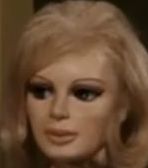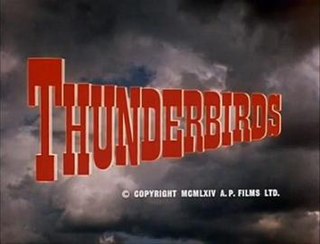Related Research Articles

Stingray is a British children's science fiction television series created by Gerry and Sylvia Anderson and produced by AP Films (APF) for ITC Entertainment. Filmed in 1963 using a combination of electronic marionette puppetry and scale model special effects, it was APF's sixth puppet series and the third to be produced under the banner of "Supermarionation". It premiered in October 1964 and ran for 39 half-hour episodes.

Thunderbirds Are Go is a 1966 British science-fiction puppet film based on Thunderbirds, a Supermarionation television series created by Gerry and Sylvia Anderson and produced by their company Century 21 Productions. Written by the Andersons and directed by David Lane, Thunderbirds Are Go concerns spacecraft Zero-X and its human mission to Mars. When Zero-X suffers a malfunction during re-entry, it is up to life-saving organisation International Rescue, supported by its technologically-advanced Thunderbird machines, to activate the trapped crew's escape pod before the spacecraft hits the ground.

Lady Penelope Creighton-Ward is a fictional character introduced in the British 1960s Supermarionation television series Thunderbirds, which was produced by AP Films (APF) for ITC Entertainment. The character also appears in the film sequels Thunderbirds Are Go (1966) and Thunderbird 6 (1968), the 2004 live-action film Thunderbirds and the CGI remake series Thunderbirds Are Go. In the world of Thunderbirds, Penelope is employed by the secret organisation International Rescue as its London field agent.
"Move – and You're Dead" is an episode of Thunderbirds, a British Supermarionation television series created by Gerry and Sylvia Anderson and filmed by their production company AP Films for ITC Entertainment. Written and directed by Alan Pattillo, it was first broadcast on 10 February 1966 on ATV Midlands as the 20th episode of Series One. It is the ninth episode in the official running order.

"Trapped in the Sky" is the first episode of Thunderbirds, a British Supermarionation television series created by Gerry and Sylvia Anderson and filmed by their production company AP Films (APF) for ITC Entertainment. Written by the Andersons, it was first broadcast on ATV Midlands on 30 September 1965.

The Century 21 Organisation was a group of companies founded by Gerry Anderson in the early 1960s to expand on his television production company, AP Films (APF; later Century 21 Productions). In addition to APF, the group included:
"The Mighty Atom" is an episode of Thunderbirds, a British Supermarionation television series created by Gerry and Sylvia Anderson and filmed by their production company AP Films for ITC Entertainment. Written by Dennis Spooner and directed by David Lane, it was first broadcast on 30 December 1965 on ATV Midlands as the 14th episode of Series One. It is the sixth episode in the official running order.
"The Perils of Penelope" is an episode of Thunderbirds, a British Supermarionation television series created by Gerry and Sylvia Anderson and filmed by their production company AP Films for ITC Entertainment. Directed by Alan Pattillo and Desmond Saunders from a script by Pattillo, it was first broadcast on 14 October 1965 on ATV Midlands as the third episode of Series One. It is the 12th episode in the official running order.
"The Cham-Cham" is the 25th episode of Thunderbirds, a British Supermarionation television series created by Gerry and Sylvia Anderson and filmed by their production company AP Films (APF). The penultimate episode of Thunderbirds Series One, it was written and directed by Alan Pattillo and first broadcast on 24 March 1966 on ATV Midlands.
"30 Minutes After Noon" is an episode of Thunderbirds, a British Supermarionation television series created by Gerry and Sylvia Anderson and filmed by their production company AP Films (APF) for ITC Entertainment. Written by Alan Fennell and directed by David Elliott, it was first broadcast on 11 November 1965 on ATV Midlands as the seventh episode of Series One. It is the 18th episode in the official running order.
"Atlantic Inferno" is the 27th episode of Thunderbirds, a British Supermarionation television series created by Gerry and Sylvia Anderson and filmed by their production company AP Films for ITC Entertainment. Written by Alan Fennell and directed by Desmond Saunders, it was first broadcast on 2 October 1966 on ATV London and Anglia Television as the first episode of Series Two. It had its first UK-wide network broadcast on 17 April 1992 on BBC2.
"Security Hazard" is the 26th episode of Thunderbirds, a British Supermarionation television series created by Gerry and Sylvia Anderson and filmed by their production company AP Films (APF) for ITC Entertainment. The final episode of Series One, it was written by Alan Pattillo, directed by Desmond Saunders, and first broadcast on 31 March 1966 on ATV Midlands. It had its first UK‑wide network transmission on 10 April 1992 on BBC2.
"Vault of Death" is an episode of Thunderbirds, a British Supermarionation television series created by Gerry and Sylvia Anderson and filmed by their production company AP Films for ITC Entertainment. Written by Dennis Spooner and directed by David Elliott, it was first broadcast on 23 December 1965 on ATV Midlands as the 13th episode of Series One. It is the seventh episode in the official running order.
"Brink of Disaster" is an episode of Thunderbirds, a British Supermarionation television series created by Gerry and Sylvia Anderson and filmed by their production company AP Films for ITC Entertainment. Written by Alan Fennell and directed by David Lane, it was first broadcast on 24 February 1966 on ATV Midlands as the 22nd episode of Series One. It is the 11th episode in the official running order.
"Martian Invasion" is an episode of Thunderbirds, a British Supermarionation television series created by Gerry and Sylvia Anderson and filmed by their production company AP Films (APF) for Lew Grade's ITC Entertainment. Written by Alan Fennell and directed by David Elliott, it was first broadcast on 17 March 1966 on ATV Midlands as the 24th episode of Series One. It is the tenth episode in the official running order.
"Alias Mr. Hackenbacker" is the 29th episode of Thunderbirds, a British Supermarionation television series created by Gerry and Sylvia Anderson and filmed by their production company AP Films for ITC Entertainment. Written by Alan Pattillo and directed by Desmond Saunders, it was first broadcast on 16 October 1966 on ATV London and Anglia Television as the third episode of Series Two.
"Path of Destruction" is the 28th episode of Thunderbirds, a British Supermarionation television series created by Gerry and Sylvia Anderson and filmed by their production company AP Films (APF) for ITC Entertainment. Written by Donald Robertson and directed by David Elliott, it was first broadcast on 9 October 1966 on ATV London and Anglia Television as the second episode of Series Two. It had its first UK-wide network broadcast on 24 April 1992 on BBC2.
Grandma Tracy is a fictional character in the puppet television series Thunderbirds and its animated remake Thunderbirds Are Go. She is the mother of Jeff Tracy and the paternal grandmother of the Tracy brothers: Scott, John, Virgil, Gordon and Alan. The character was voiced by Christine Finn in the original series and Sandra Dickinson in the remake.

Thunderbirds is a British science fiction television series created by Gerry and Sylvia Anderson, filmed by their production company AP Films (APF) and distributed by ITC Entertainment. It was made between 1964 and 1966 using a form of electronic marionette puppetry combined with scale model special effects sequences. Two series, totalling thirty-two 50-minute episodes, were filmed; production ended with the completion of the sixth episode of the second series after Lew Grade, the Andersons' financial backer, failed in his bid to sell the programme to American network television.
This article primarily discusses screen and audio works of fiction based on Thunderbirds, a British Supermarionation television series created by Gerry and Sylvia Anderson. It also covers imitations and references in other media.
References
- 1 2 3 4 Bentley, Chris (2005) [2000]. The Complete Book of Thunderbirds (2nd ed.). London, UK: Carlton Books. p. 83. ISBN 978-1-84442-454-2.
- 1 2 Anderson, Sylvia (1991). Yes, M'Lady. London, UK: Smith Gryphon. p. 110. ISBN 978-1-85685-011-7. Archived from the original on 30 December 2012.
- 1 2 3 4 Jones, Mike (2015). Thunderbirds: Close-Up. Fanderson. p. 43.
- 1 2 Bentley, Chris (2008) [2001]. The Complete Gerry Anderson: The Authorised Episode Guide (4th ed.). London, UK: Reynolds & Hearn. p. 106. ISBN 978-1-905287-74-1.
- ↑ Rogers, Dave; Marriott, John; Drake, Chris; Bassett, Graeme (1993). Supermarionation Classics: Stingray, Thunderbirds and Captain Scarlet and the Mysterons. London, UK: Boxtree. p. 148. ISBN 978-1-85283-900-0.
- 1 2 3 4 McGown, Alistair (September 2015). Hearn, Marcus (ed.). Thunderbirds – A Complete Guide to the Classic Series. Tunbridge Wells, UK: Panini UK. p. 69. ISBN 978-1-84653-212-2.
- ↑ de Klerk, Theo (5 August 2013). "Complete Studio-Recording List of Barry Gray". tvcentury21.com. Archived from the original on 15 June 2018. Retrieved 26 October 2021.
- ↑ Bentley, Chris (2001). The Complete Book of Captain Scarlet. London, UK: Carlton Books. p. 76. ISBN 978-1-842224-05-2.
- ↑ Bentley, Chris (2017). Hearn, Marcus (ed.). Captain Scarlet and the Mysterons: The Vault. Cambridge, UK: Signum Books. p. 131. ISBN 978-0-995519-12-1.
- ↑ Brown, Stephen; Jones, Mike (2018). Jones, Mike (ed.). Joe 90: Close-Up. Fanderson. p. 43.
- ↑ Hearn 2015, p. 82.
- 1 2 Fox, Tom (August 2004). Payne, Andrew (ed.). "TV View". Starburst Special . No. 65. London, UK: Visual Imagination. p. 50. ISSN 0958-7128.
- 1 2 3 4 Hearn 2015, p. 146.
- 1 2 Hearn 2015, p. 84.
- 1 2 Cull, Nicholas J. (August 2006). "Was Captain Black Really Red? The TV Science Fiction of Gerry Anderson in its Cold War Context". Media History. 12 (2). Routledge: 198–199. doi:10.1080/13688800600808005. ISSN 1368-8804. OCLC 364457089. S2CID 142878042.
- ↑ Reavley, Morag (2003). "Thunderbirds Original Soundtrack Review". BBC Online . Archived from the original on 12 February 2011. Retrieved 26 October 2021.
Works cited
- Hearn, Marcus (2015). Thunderbirds: The Vault. London, UK: Virgin Books. ISBN 978-0-753-55635-1.